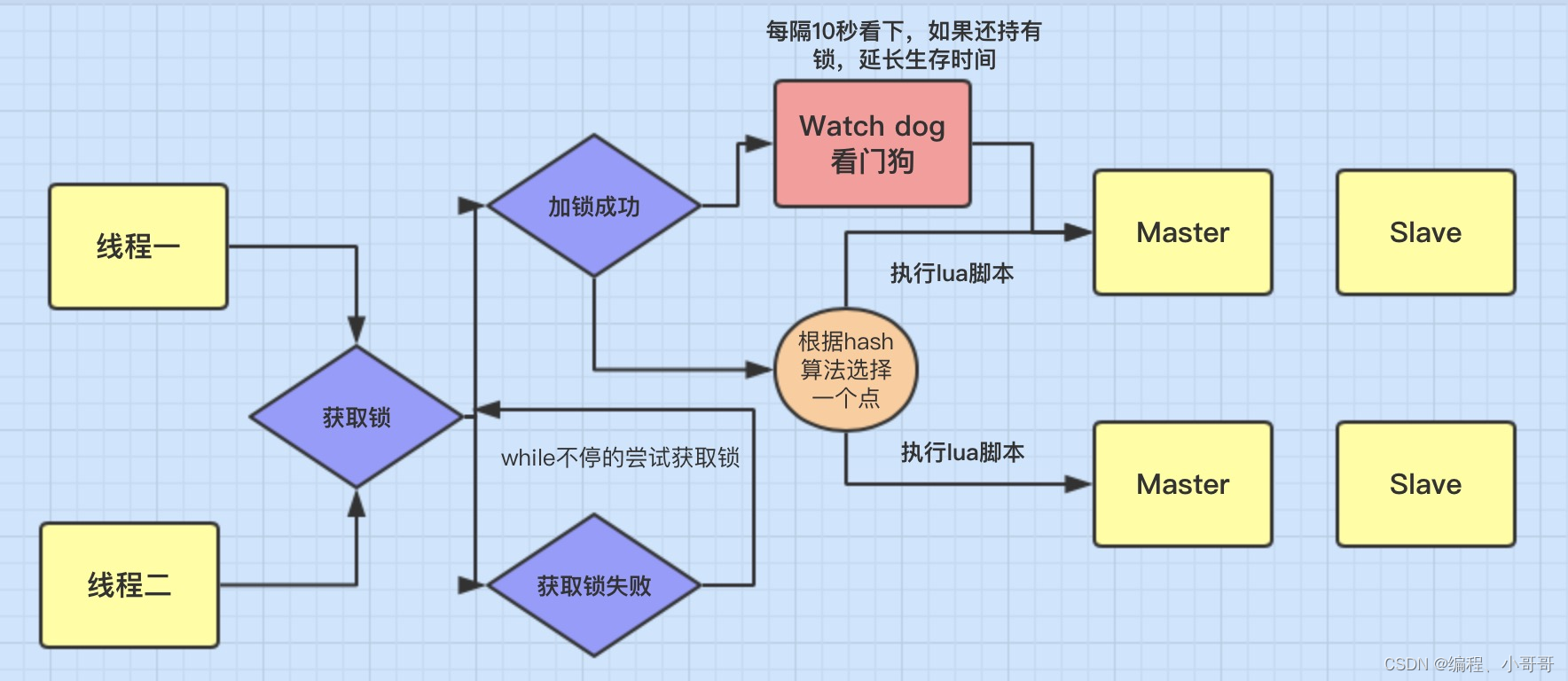什么是Redisson?
俗话说他就是看门狗,看门狗机制是一种用于保持Redis连接活跃性的方法,通常用于分布式锁的场景。看门狗的工作原理是:当客户端获取到锁之后,会对Redis中的一个特定的键设置一个有限的过期时间,然后每隔一段时间(默认是15秒),客户端会对这个键“续约”,即重新设置它的过期时间,以此来保持锁的持有状态,防止锁因为某些原因(如客户端崩溃或网络问题)而被释放。

以下是核心实战部分
配置文件读取
@ConfigurationProperties(prefix = "spring.redis.redisson"
)
@Data
public class RedissonProperties {/*** key前缀*/private String keyPrefix;/*** 拿锁等待时间(毫秒)*/private long waitTime = 10000;/*** 默认ttl时间(毫秒)*/private long leaseTime = 60000;@Value("${spring.redis.redisson.config.clusterServersConfig.nodeAddresses}")private String nodeAddresses;@Value("${spring.redis.redisson.config.clusterServersConfig.scanInterval}")private Integer scanInterval;@Value("${spring.redis.redisson.config.threads}")private Integer threads;@Value("${spring.redis.redisson.config.nettyThreads}")private Integer nettyThreads;@Value("${spring.redis.redisson.config.transportMode}")private String transportMode;
}yml文件
spring:##redis集群配置redis:database: 0timeout: 5000msredisson:config:clusterServersConfig:nodeAddresses: redis://10.xxx.xx.x1:6379,redis://10.xxx.xx.x2:6379,redis://10.xxx.xx.x3:6379scanInterval: 1000nettyThreads: 0threads: 0transportMode: NIOkey-prefix: test:keylease-time: 80000wait-time: 50000
redisson自动配置类
@Configuration
@ConditionalOnClass({Redisson.class})
@EnableConfigurationProperties({RedissonProperties.class})
@Slf4j
public class RedissonAutoConfiguration {@Bean@ConditionalOnMissingBean({RedisConnectionFactory.class})public RedissonConnectionFactory redissonConnectionFactory(RedissonClient redisson) {return new RedissonConnectionFactory(redisson);}@Bean(destroyMethod = "shutdown")@ConditionalOnMissingBean({RedissonClient.class})public RedissonClient redisson(RedissonProperties redissonProperties) throws IOException {Config config = new Config();config.useClusterServers().addNodeAddress(redissonProperties.getNodeAddresses().split(",")).setScanInterval(redissonProperties.getScanInterval());config.setThreads(redissonProperties.getThreads()).setNettyThreads(redissonProperties.getNettyThreads()).setTransportMode(TransportMode.valueOf(redissonProperties.getTransportMode()));return Redisson.create(config);}@Bean@ConditionalOnMissingBean(name = {"redisTemplate"})public RedisTemplate<Object, Object> redisTemplate(RedisConnectionFactory redisConnectionFactory) throws UnknownHostException {RedisTemplate<Object, Object> template = new RedisTemplate();template.setConnectionFactory(redisConnectionFactory);return template;}@Bean@ConditionalOnMissingBeanpublic StringRedisTemplate stringRedisTemplate(RedisConnectionFactory redisConnectionFactory) throws UnknownHostException {StringRedisTemplate template = new StringRedisTemplate();template.setConnectionFactory(redisConnectionFactory);return template;}}redis的缓存类实现
@Service
public class RedisCache {@Autowiredprivate RedissonClient redisson;@Autowiredprivate RedissonProperties redissonProperties;/*** 缓存** @param key 缓存key* @param <T>* @return 缓存返回值*/public <T> T get(String key) {RBucket<T> bucket = redisson.getBucket(getKey(key));return bucket.get();}/*** 以string的方式读取缓存** @param key 缓存key* @return 缓存返回值*/public String getString(String key) {RBucket<String> bucket = redisson.getBucket(getKey(key), StringCodec.INSTANCE);return bucket.get();}/*** 以string的方式保存缓存(与其他应用共用redis时需要使用该函数)** @param key 缓存key* @param value 缓存值* @param expiredTime 缓存过期时间*/public void putString(String key, String value, long expiredTime) {RBucket<String> bucket = redisson.getBucket(getKey(key), StringCodec.INSTANCE);bucket.set(value, expiredTime, TimeUnit.MILLISECONDS);}/*** 如果不存在则写入缓存(string方式,不带有redisson的格式信息)** @param key 缓存key* @param value 缓存值* @param expiredTime 缓存过期时间*/public boolean putStringIfAbsent(String key, String value, long expiredTime) {RBucket<String> bucket = redisson.getBucket(getKey(key), StringCodec.INSTANCE);return bucket.trySet(value, expiredTime, TimeUnit.MILLISECONDS);}/*** 设置缓存** @param key 缓存key* @param value 缓存值* @param expiredTime 缓存过期时间* @param <T> 类型*/public <T> void put(String key, T value, long expiredTime) {RBucket<T> bucket = redisson.getBucket(getKey(key));bucket.set(value, expiredTime, TimeUnit.MILLISECONDS);}/*** 如果不存在则设置缓存** @param key 缓存key* @param value 缓存值* @param expiredTime 缓存过期时间* @param <T> 类型*/public <T> void putIfAbsent(String key, T value, long expiredTime) {RBucket<T> bucket = redisson.getBucket(getKey(key));bucket.trySet(value, expiredTime, TimeUnit.MILLISECONDS);}/*** 移除缓存** @param key*/public void remove(String key) {redisson.getBucket(getKey(key)).delete();}/*** 判断缓存是否存在** @param key* @return*/public boolean exists(String key) {return redisson.getBucket(getKey(key)).isExists();}private String getKey(String key) {return StringUtils.format("{0}:{1}", redissonProperties.getKeyPrefix(), key);}
获取和释放分布式锁接口
DistributedLock
/*** get分布式锁* @param lockKey* @param requestId* @param expireTime* @return*/public boolean getDistributedLock(String lockKey, String requestId, long expireTime);/*** remove分布式锁* @param lockKey* @param requestId* @return*/public boolean removeDistributedLock(String lockKey, String requestId);
实现DistributedLock的实现类逻辑
@Service
public class RedisDistributedLocker implements DistributedLocker {private static final Logger logger = LoggerFactory.getLogger(RedisDistributedLocker.class);@Autowiredprivate RedissonClient redisson;@Autowiredprivate RedissonProperties redissonProperties;public boolean getDistributedLock(String lockKey, String flagId, long expireTime) {boolean success;try {if (expireTime == 0) {expireTime = redissonProperties.getLeaseTime();}lockKey = StringUtils.format("{0}:{1}", redissonProperties.getKeyPrefix(), lockKey);RLock locker = redisson.getLock(lockKey);success = locker.tryLock(redissonProperties.getWaitTime(), expireTime, TimeUnit.MILLISECONDS);} catch (Exception e) {success = false;logger.error(StringUtils.format("获取分布式锁失败,lockKey={0}, flagId={1}, expirTime={2}", lockKey, flagId, expireTime), e);}return success;}public boolean releaseDistributedLock(String lockKey, String flagId) {boolean success = false;try {lockKey = StringUtils.format("{0}:{1}", redissonProperties.getKeyPrefix(), lockKey);RLock locker = redisson.getLock(lockKey);if (locker.isHeldByCurrentThread()) {locker.unlock();success = true;}} catch (Exception e) {success = false;logger.error(StringUtils.format("分布式锁失败,lockKey={0}, flagId={1}", lockKey, flagId), e);}return success;}
在需要的业务场景下使用 以下为伪代码
try {boolean ock = distributedLocker.getDistributedLock(lockKey, flagId, 9000L);if (!ock) {return;}// 实现自己的业务逻辑。。。。。。。。。。。。。。。。。。。。。。。。。} catch (Exception e) {e.printStackTrace();throw new RuntimeException(e.getMessage());} finally {distributedLocker.releaseDistributedLock(lockKey, flagId);}
以上的是分布式锁之RedissonLock 若需完整代码 可识别二维码后 给您发代码。

![[附源码]传世手游_玲珑传世_GM_安卓搭建教程](http://pic.xiahunao.cn/[附源码]传世手游_玲珑传世_GM_安卓搭建教程)

)











 Docker 组挂载)



销售数据分析)
